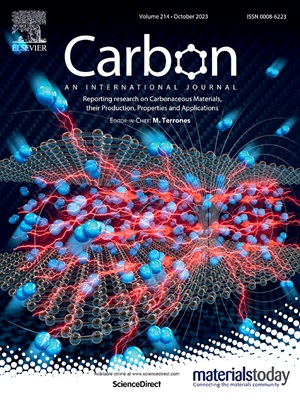Mechanistic insights into oxygen–boron co-doping in activated carbon: Tailoring surface chemistry and wettability
IF 11.6
2区 材料科学
Q1 CHEMISTRY, PHYSICAL
引用次数: 0
Abstract
Oxygen (O) and Boron (B) heteroatom doping has emerged as a promising strategy to enhance the capacitive performance of activated carbon (AC) for supercapacitors. However, the synergistic mechanism between these heteroatoms remains ambiguous due to intertwined morphological and compositional changes during conventional doping processes. This study employs a stepwise doping methodology to independently control O and B concentrations while preserving the structural integrity of AC. Through sequential high-temperature B doping and low-temperature oxidation, dual-doped AC (AC-O-B) retains comparable specific surface area and pore structure to pristine AC. Electrochemical evaluations reveal that O–B double doping has no significant effect on the double-layer capacitance, but it greatly improves the pseudocapacitance. Mechanistic analysis demonstrates that O doping introduces abundant C–O groups and facilitating the formation of BC2O structures via B integration. The presence of C–O groups and BC2O structure not only enhance surface wettability but also optimize charge transfer kinetics and redox-active site density. This work provides critical insights into heteroatom co-doping strategies for designing high-performance carbon-based supercapacitors.

活性碳中氧硼共掺杂的机理:裁剪表面化学和润湿性
氧(O)和硼(B)杂原子掺杂已成为提高超级电容器活性炭(AC)电容性能的一种很有前途的策略。然而,这些杂原子之间的协同机制仍然不清楚,因为在传统的掺杂过程中,这些杂原子的形态和成分的变化交织在一起。本研究采用逐步掺杂的方法来独立控制O和B的浓度,同时保持AC的结构完整性。通过连续的高温B掺杂和低温氧化,双掺杂AC (AC-O-B)保持了与原始AC相当的比表面积和孔结构。电化学评价表明,O-B双掺杂对双层电容没有显著影响,但极大地改善了赝电容。机理分析表明,O掺杂引入了丰富的C-O基团,通过B整合促进了BC2O结构的形成。C-O基团和BC2O结构的存在不仅提高了表面润湿性,而且优化了电荷转移动力学和氧化还原活性位点密度。这项工作为设计高性能碳基超级电容器的杂原子共掺杂策略提供了重要的见解。
本文章由计算机程序翻译,如有差异,请以英文原文为准。
求助全文
约1分钟内获得全文
求助全文
来源期刊

Carbon
工程技术-材料科学:综合
CiteScore
20.80
自引率
7.30%
发文量
0
审稿时长
23 days
期刊介绍:
The journal Carbon is an international multidisciplinary forum for communicating scientific advances in the field of carbon materials. It reports new findings related to the formation, structure, properties, behaviors, and technological applications of carbons. Carbons are a broad class of ordered or disordered solid phases composed primarily of elemental carbon, including but not limited to carbon black, carbon fibers and filaments, carbon nanotubes, diamond and diamond-like carbon, fullerenes, glassy carbon, graphite, graphene, graphene-oxide, porous carbons, pyrolytic carbon, and other sp2 and non-sp2 hybridized carbon systems. Carbon is the companion title to the open access journal Carbon Trends. Relevant application areas for carbon materials include biology and medicine, catalysis, electronic, optoelectronic, spintronic, high-frequency, and photonic devices, energy storage and conversion systems, environmental applications and water treatment, smart materials and systems, and structural and thermal applications.
 求助内容:
求助内容: 应助结果提醒方式:
应助结果提醒方式:


